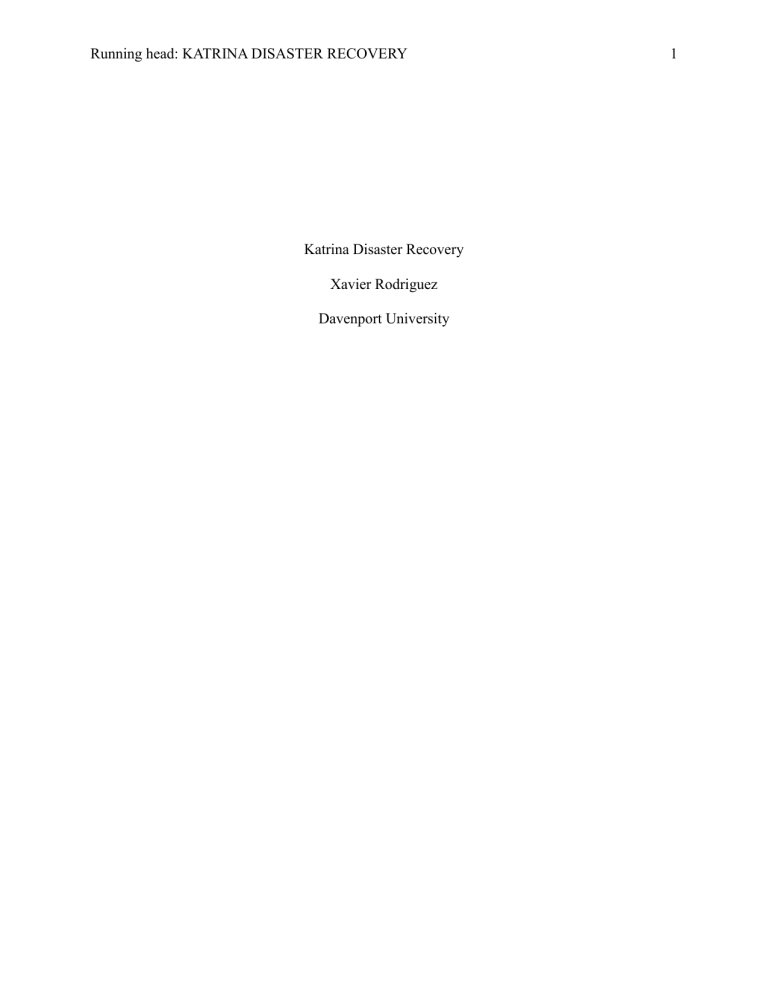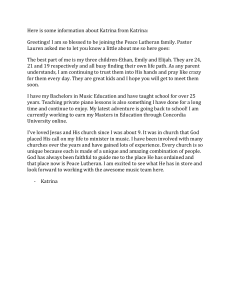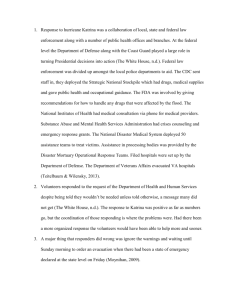
Running head: KATRINA DISASTER RECOVERY Katrina Disaster Recovery Xavier Rodriguez Davenport University 1 KATRINA DISASTER RECOVERY 2 Katrina Disaster Recovery Sixteen years ago, devastation swept through New Orleans and the Gulf Coast. Hurricane Katrina one of the strongest Atlantic hurricanes ever recorded caused long lasting damage to citizens and businesses alike. Over 7900 businesses closed their doors permanently in the aftermath (Chu, 2007). This disaster challenged the nation's confidence in the disaster recovery plans of organizations. Some businesses such as Walmart reacted decisively and efficiently. Others struggled just to keep their doors open. LifeShare Blood Centers was one of those companies. LifeShare Blood Centers, supplies over a hundred medical facilities in Louisiana with vital red blood cells and plasma. LifeShare also collects and processes data concerning five hundred donors on any given day. This data is crucial to gather and distribute its life-saving blood supply. Additionally, LifeShare’s policies and procedures must comply with regulatory bodies such as the U.S. Food and Drug administration and the AABB standards. As a result, the facilities data center located in Shreveport could not afford to be down. Ric Jones, the CIO of LifeShare recalls the impact of Katrina on his organization. “When Hurricane Katrina’s devastation struck New Orleans, several of our regional centers were closed, demand for blood products substantially increased and donors were not able to give blood due to our site closures, interrupting the flow of business.” As disastrous as this was, Ric goes on to admit his organization's lack of planning could have cost lives. He goes on to say, “We did not have a disaster recovery plan in place when Katrina struck our office in Shreveport Louisiana and several other regional centers. The storm closed several locations, and as a result, kept blood donors from being able to give blood at a time of substantial demand increase. The levels of critical blood types dropped to dangerously low levels” (Bradley, 2015). It was only after Katrina that LifeShare decided to find a better and more reliable solution to their IT infrastructure. To KATRINA DISASTER RECOVERY 3 address this LifeShare has since decided to use SunGard Availability Services Recover2Cloud for its data. This protection covers its 12 servers, applications that handle blood donor’s data, inventory, as well as financial and payroll systems. SunGard has since backed up LifeShare’s servers and updated their VMware infrastructure. A mirror copy of LifeShare’s data now exists in SunGard’s secure northeast data center. LifeShare’s IT staff could now view in real-time statistics about the data backup of its 12 servers. LifeShare IT department works closely with SunGard to ensure the data is backed up and protected. Upon hearing the cautionary tale of LifeShare Blood Centers I can make some suggestions for the organization's contingency plan going forward. My first suggestion is to have a disaster recovery plan. Ric notes his company did not have one in place at the time of Katrina. This suggests to me a lack of a proper risk assessment as their assets are critical to not only the company’s welfare but the communities. Businesses will face a disaster event at some point, and you should have a clear plan in place. This plan must define how to respond appropriately to disasters and how to return to normal business operations as soon as possible. This plan should be a living document that is reviewed and updated regularly. Secondly, it seems to me that with the SunGard partnership the company wants to take a transference approach to risk. “Transference is the control approach that attempts to shift the risk to other assets, other processes, or other organizations” (Whitman & Mattord 2007). In this case they should evaluate other reliable vendors who can perform necessary information security and assurance. This is essential because they have a small IT staff that presides over seven blood centers. This includes computer systems, desktops, mobile PCs, 800 workstations and printers across the whole organization. After All, if they did not have a disaster recovery plan before Katrina, I doubt they have one for a ransomware or other cyber threats. Finally, they should understand that redundancy is a necessary element of business continuity. KATRINA DISASTER RECOVERY Thankfully, LifeShare now works with SunGard Availability Services that provide them with disaster recovery and cloud-based resiliency. “If the Shreveport center is down for one or two days, it can’t collect the data it needs to provide blood on demand. Due to this, we have the mirror copy of our Shreveport-based data systems replicated in SunGard AS’ northeast data center,” said Ric Jones. 4 KATRINA DISASTER RECOVERY 5 References Bradley, T. (2015, August 28). The disaster recovery lessons we learned after Katrina. CSO Online. https://www.csoonline.com/article/2977193/the-disaster-recovery-lessons-welearned-after-katrina.html. Chu, K. (2007, August 29). Smaller businesses struggle to recover from Katrina. ABC News. https://abcnews.go.com/Business/story?id=3535684&page=1. Whitman, M. E., & Mattord, H. J. (2007). Principles of incident response and disaster recovery.






